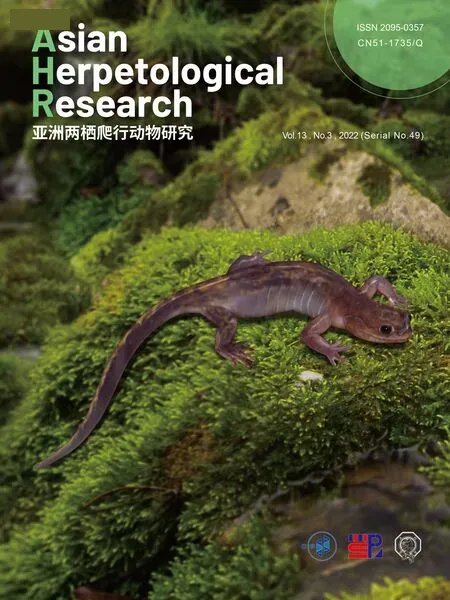Partial Masquerading and Background Matching in Two Asian Box Turtle Species (Cuora spp.)
2022-09-27RongpingBUFanrongXIAOGeorgeLOVELLJichaoWANGandHaitaoSHI
Rongping BU ,Fanrong XIAO* ,P.George LOVELL ,Jichao WANG and Haitao SHI*
1 Ministry of Education Key Laboratory for Ecology of Tropical Islands, Key Laboratory of Tropical Animal and Plant Ecology of Hainan Province,College of Life Sciences,Hainan Normal University,Haikou 571158,Hainan,China
2 Division of Psychology and Forensic Sciences,School of Applied Sciences,Abertay University,Dundee DD1 1HG,UK
Abstract Animals living in heterogeneous natural environments adopt different camouflage strategies against different backgrounds,and behavioral adaptation is crucial for their survival.However,studies of camouflage strategies have not always quantified the effect of multiple strategies used together.In the present study,we used a human visual model to quantify similarities in color and shape between the carapace patterns of two Cuora species and their preferred habitats.Our results showed that the color of the middle stripe on the carapace of Cuora galbinifrons(Indochinese box turtle) was significantly similar to the color of their preferred substrates.Meanwhile,the middle stripe on the carapace of C.mouhotii (keeled box turtle) contrasted more with their preferred substrates,and the side stripe matched most closely with the environment.Furthermore,the carapace side stripe of C.galbinifrons and the carapace middle stripe of C.mouhotii highly contrasted with their preferred substrates.We quantified the similarity in shape between the highcontrast stripes of both Cuora species and leaves from their habitats.The carapace middle stripe of C.mouhotii was most similar in shape to leaves from the broadleaves substrate,and the carapace side stripe of C.galbinifrons was the most similar in shape to leaves from the bamboo-leaves substrate.We determined that these species adopt partial masquerading when their entire carapace is exposed and partially match their background when they semi-cover themselves in leaf litter.To the best of our knowledge,this is the first study to demonstrate that partial masquerading and background matching improve the camouflage effect of Asian box turtles in their preferred habitats.This is a novel study focusing on the influence of the shape and color of individual carapace segments on reducing detectability and recognition.
Keywords camouflage,Cuora galbinifrons,Cuora mouhotii,patterns,protective coloration
1.Introduction
Camouflage,the phenomenon in which the characteristics of an object or organism are arranged to prevent detection or recognition by an observer,is a common anti-predator strategy employed by many animals (Endler,1978;Merilaita and Lind,2005;Stevens and Merilaita,2011) and is crucial for survival in many species (Cott,1940;Ruxtonet al.,2004).Background matching,an important camouflaging strategy that helps an animal reduce detection by predators (Stevenset al.,2015;Stevens and Merilaita,2011),refers to the matching of the animals’ color,lightness,orientation,and pattern with their background (Kanget al.,2012;Marshallet al.,2016;Trosciankoet al.,2016).Masquerading animals appear to closely resemble inedible or inanimate objects,such as twigs,leaves,stones,or bird droppings (Endler,1981;Skelhornet al.,2010a),preventing predators from detecting or recognizing them.
However,it is difficult to determine whether a predator has detected and misidentified a camouflaged individual (due to masquerade) or entirely failed to detect the prey individual (due to background matching and disruptive coloration) (Skelhornet al.,2010a;Skelhorn and Ruxton,2011).Thus,considering these two camouflage strategies separately is neither a requirement nor a realistic interpretation of the real world (Stevenset al.,2011).Prey animals can exploit background matching and masquerading simultaneously to increase the anti-predation benefits of the strategies.Under these circumstances,the benefit and impact of each strategy may differ,as would the overall effect of the combined strategies (Hallet al.,2017).
To maximize the effectiveness of the camouflage,animals likely choose microhabitats that closely complement their color and shape (Lovellet al.,2013;Priceet al.,2019;Stevens and Ruxton,2018).For example,the common potoo bird (Nyctibius griseus) selects perching sites that enhance its background matching and masquerading effects (Cestariet al.,2018).Furthermore,many animals decorate themselves or modify their habitats to better conceal themselves (Gómezet al.,2018;Marshallet al.,2016;Suzuki and Sakurai,2015).
Camouflage is likely the main defense mechanism for turtles,as they are slow moving and relatively easy to catch (Hallet al.,2017).Thus,camouflage is an important anti-predation mechanism that improves their fitness.Some tortoise species have been described as having a likeness to stones (Willemsen and Hailey,2003),and evidence suggests that desert tortoises(Gopherus agassizii) select habitats that contain stones similar in size to their own body size,which can reduce their detectability(Nafuset al.,2015).There have been studies of color variation induced in turtles based on their habitats (McGaugh,2008;Roweet al.,2014).However,few studies have explored color and shape similarities between turtles and habitats,or their models(see Xiaoet al.,2016,2021).Moreover,these studies examined the animal as a whole rather than examining whether certain body parts of the animal impact camouflage.
In our long-term field studies on Indochinese box turtles(C.galbinifrons) and keeled box turtles (C.mouhotii) (Buet al.,2020;Xiaoet al.,2017),we discovered that the carapace roof of the former exhibits a bamboo-leaved pattern,specifically two yellow stripes (Figure 1A),while the carapace roof of the latter exhibits a broad-leaved pattern,created by two keels (Figure 1B).These patterns facilitate disruptive camouflage in their preferred substrates (Buet al.,2020).Both box turtle species bury their bodies in leaf litter when they are still,leaving the middle stripe exposed,which appears to match the surrounding substrate (Figure 2).Both species face predators in the wild,mainly mammals,such as the masked palm civet (Paguma larvata) and wild boar (Sus scrofa) (Xiaoet al.,2020).
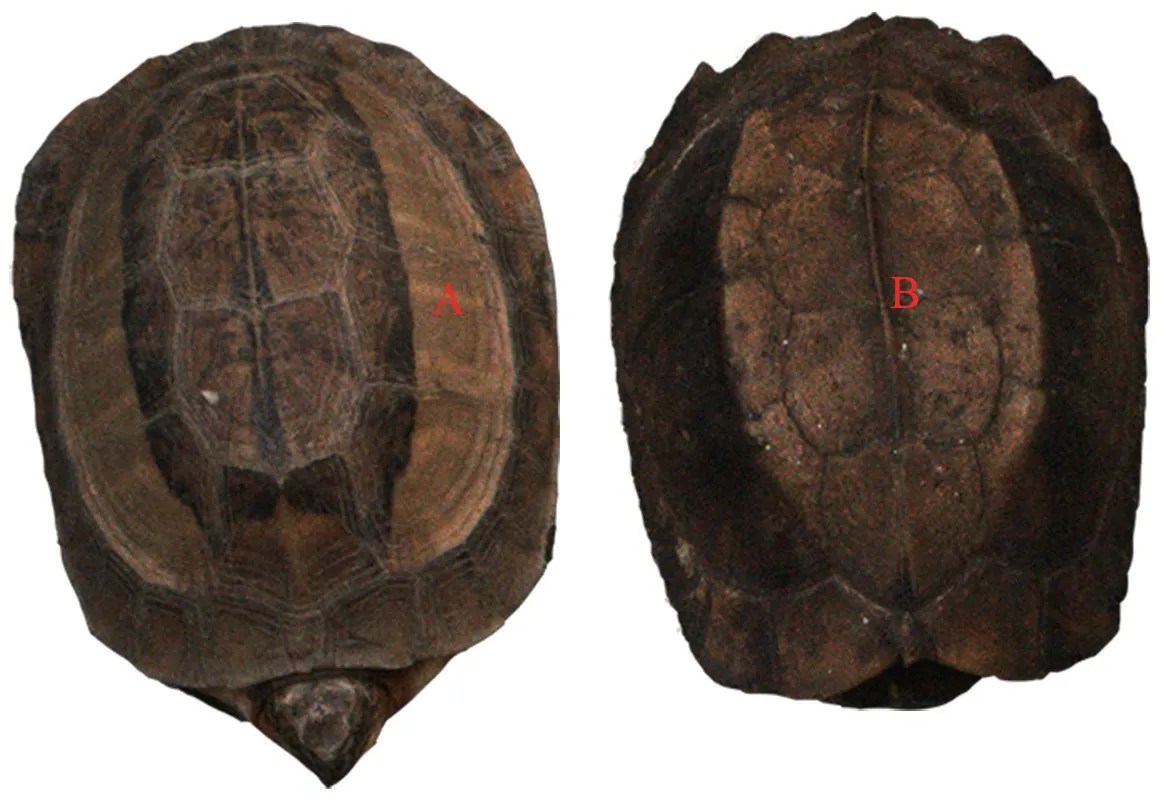
Figure 1 The carapace of an Indochinese box turtle (left) and a keeled box turtle (right).A indicates the yellow stripe of the Indochinese box turtle,and B is the middle stripe of the keeled box turtle.
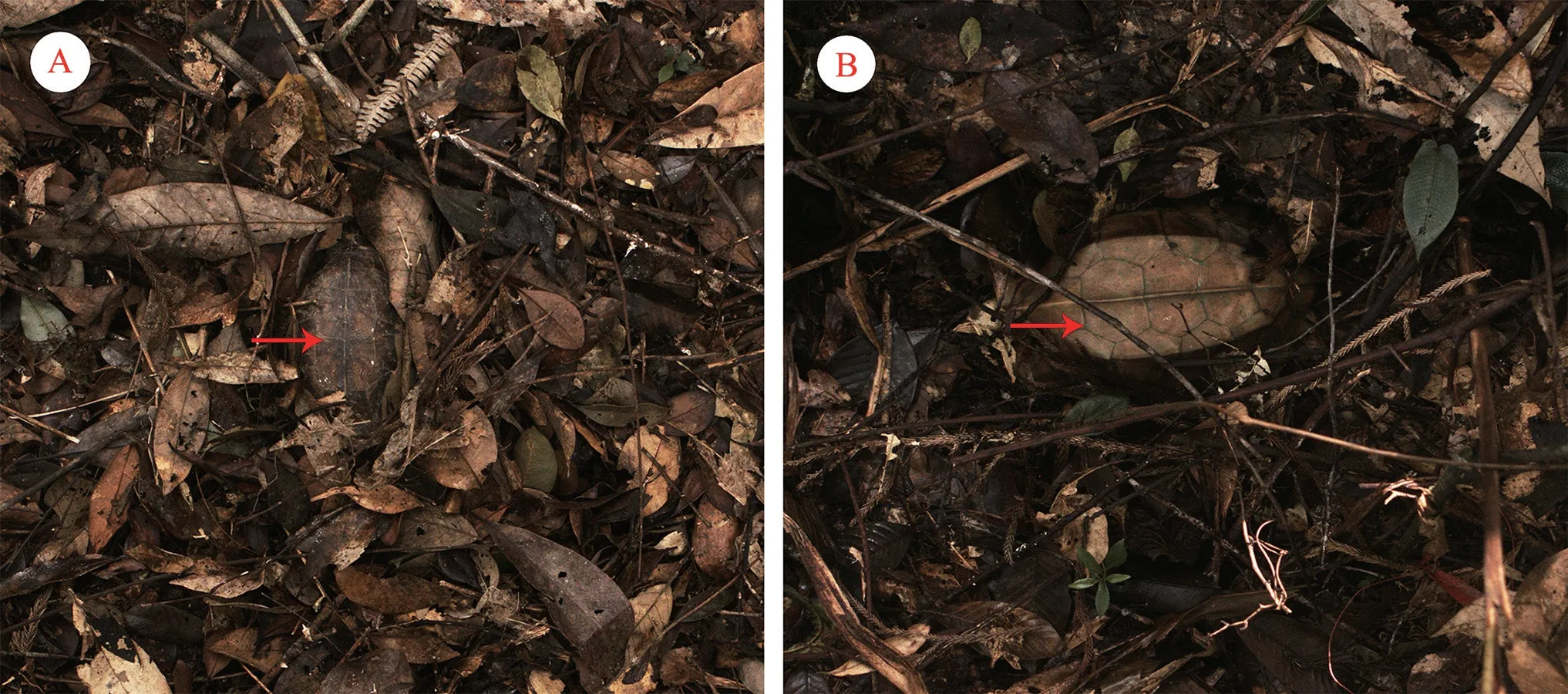
Figure 2 Both turtle species bury themselves in leaf litter,leaving the middle stripe exposed.Arrows indicate Indochinese box turtle(Cuora galbinifrons) (A) and keeled box turtle (Cuora mouhotii) (B).
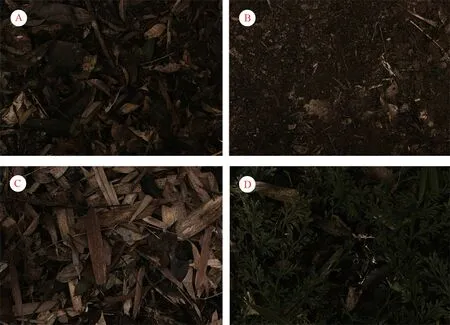
Figure 3 Four kinds of backgrounds: A is an example of a broad-leaves substrate,B is a bare ground substrate,C is a bamboo-leaves substrate,and D is a grass substrate.
In the present study,we predicted that the middle stripes on the carapace roof of these twoCuoraspecies had evolved to match their preferred habitat,masquerading as leaves and serving an anti-predation purpose.To the best of our knowledge,this study is the first to focus on the anti-predation benefits associated with partial stripe color and shape variation in box turtles.
2.Materials and Methods
2.1.Ethics statementFieldwork was carried out in strict accordance with the guidelines of the Animal Research Ethics Committee of Hainan Provincial Education Centre for Ecology and Environment,Hainan Normal University(HNECEE-2019-006),which conforms to the Law of the People’s Republic of China.No turtles were euthanized for this study,and none were injured while in the traps.All turtles were released in the original capture area at the end of the experiment.
2.2.Microhabitat selection,photography,and calibrationThis study was conducted from September to December 2019.Field work was conducted in a rainforest in the Diaoluoshan National Nature Reserve (18°43′53′N,109°52′10′E)in Hainan Province,People’s Republic of China.In total,12 adult Indochinese box turtles (carapace length ≥120 mm;seven females and five males) and 12 adult keeled box turtles(carapace length ≥140 mm;eight females and four males)from the reserve were used for this study.The turtles did not exhibit obvious sexual dimorphism in terms of their carapace color.The preferred microhabitats of the keeled box turtle were broad leaves (Figure 3A) and bare ground (Figure 3B),and the preferred microhabitats of the Indochinese box turtle were broad leaves (Figure 3A) and bamboo leaves (Figure 3C),as determined using radio tracking data that recorded the turtles’ movements from April 2015 to February 2016 (for detailed methodology see Xiaoet al.,2017).Grass microhabitats were not favored by either species and served as the control(Figure 3D).Turtles and substrates were photographed using a Canon EOS 550D camera with a Canon lens (EF-S24-70 mm f/2.8,8.2 megapixels).Photography in the field took place between 9:00 a.m.and 4:00 p.m.,when natural light allowed turtles to be seen.A black umbrella was used to counter the direction of light entry and ensure uniform illumination of the photos.A tripod was used to ensure that the lens was perpendicular and placed at the same distance from the substrates,so that a constant image scale could be maintained.We collected 20 images of each substrate type and 24 images of turtles,totaling 104 images.
Images were saved in an uncompressed RAW format(Stevenset al.,2007) for subsequent color measurements and analyses.The images were calibrated using the “Generate multispectral image” function in ImageJ 1.53e (Wayne Rasband and contributors,National Institutes of Health,USA)(Troscianko and Stevens,2015).The images were ordered linearly based on radiance and standardized to control for differing light conditions by using an 18% standard gray card (Mennon,China,14.5 cm×9.5 cm) (Stevenset al.,2007;Troscianko and Stevens,2015).
2.3.Color measurement and calculationStandardized images were used to quantify the color contrast between the turtles’ carapace and the substrates,following previously published protocols for images and survey methods (Buet al.,2020).A model of human discrimination was produced using MICA toolbox in ImageJ 1.53e (Wayne Rasband and contributors,National Institutes of Health,USA) (Troscianko and Stevens,2015;Priceet al.,2019;van den Berget al.,2020).As visual searching is an important method that humans use to find turtles (Nafuset al.,2015;Xiaoet al.,2016),we used human eyesight to evaluate whether color differences are distinguishable.According to the RNL model (Receptor Noise Limited Model) (Vorobyev and Osorio,1998),the chromatic just-noticeable difference (CJND) and luminance just-noticeable difference (LJND) determine whether two objects can be differentiated,with increasing values suggesting decreased color similarity.In the present study,we evaluated the color contrast between both species and their substrates by eye.We used the elm 52-mm human D65 calibration profile as a cone model.We compared the entire carapace,the middle stripe,the side stripes(Figure 4),and five randomly selected areas of each substrate with the substrate color.In addition,we randomly selected three to five leaves from each substrate to represent the leaf color.
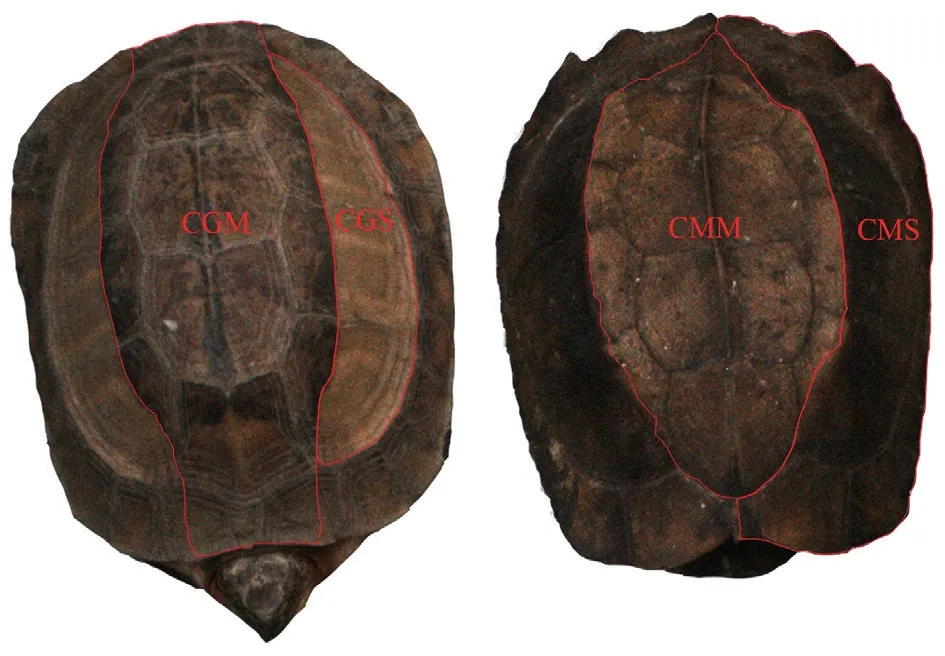
Figure 4 Color and structure segmentation diagram for a Cuora galbinifrons individual,with a carapace length of 176.64 mm,including CGM=middle stripe and CGS=side stripe,and a Cuora mouhotii individual,with a carapace length of 161.78 mm,with CMM=middle stripe and CMS=side stripe.
We converted the standard multispectral image to a cone catch,used the human visual system in sunlight (D65),and set the Weber coefficient as 0.02 (Wyszecki and Stiles,1982)to analyze the chromaticity and luminance of each image(Troscianko and Stevens,2015).The luminance channel was set to “lum” for the human vision model.We used pixels with a starting size of 2 and an ending size of 512.At each step,the pixels were multiplied by 1.414,to represent exponential growth.Luminance measurements ranged from 0 to 65,535 (Nokelainenet al.,2020).These calculations were performed by a third party who was unaware of the aim of the study.The values of CJND ranged from three to eight,depending on the image content and on each individual subject (Linet al.,2015).
2.4.Shape measurement and similarity calculationsStandardized images were imported into ImageJ 1.53e and converted into TIFF format.Scales with actual measurement values for area (A) and perimeter (P) were selected.In addition,four further descriptors were used: aspect ratio (AR),solidity (S),circularity (C),and roundness (R).These six shape descriptors were used to quantify the shapes of turtles’ carapaces and the leaves in the substrates.
According to the similarity algorithm (Samalet al.,2004),descriptor similarity is obtained by standardizing the differences between the prey and the model,as follows:

where sim (X,Y) is the similarity between objectsXandY;dis(X,Y) represents the Euclidean distance between objectsXandY;andUis the maximum distance between the corresponding features of the two elements.
The weighted average of similarity between shape descriptorsXandYwas calculated as follows:

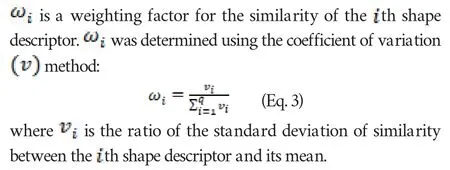
The shape similarity between turtles’ carapace and substrate leaves was then calculated based on Equations 2 and 3,withq=6 representing the six shape descriptors.The values of shape similarity ranged from 0-1,with increasing values equating to higher misidentification rates by human predators (Xiaoet al.,2021).We calculated shape similarity for the entire carapace,the middle stripe,and the side stripes (Figure 4).
2.5.Statistical analysisAll statistical analyses were performed using SPSS Statistics for Windows,version 18.0 (SPSS Inc.,Chicago,IL,USA),and all data are expressed as mean ± SE.A Kolmogorov-Smirnov test was used to test the normality of CJND,LJND,and the shape similarity data before analysis.Differences in CJND,LJND,and shape between each species,and similarity differences between each substrate type,were analyzed using the independent samples t-test when data were normally distributed;the rest of the data were analyzed using Mann-Whitney U-tests.The significance level was set atP<0.05.
3.Results
3.1.Color contrast between turtles and substratesThe CJND of the middle stripe and entire carapace ofC.galbinifronsindividuals were significantly lower in the turtles’ preferred substrates (broad leaves and bamboo leaves) than in the grass substrate.Their side stripe had the lowest contrast with the bamboo-leaves substrate and contrasted more with the broadleaves substrate than with the grass substrate.The CJND of the entire carapace ofC.mouhotiiindividuals was higher on bare ground than on the grass substrate;however,it did not differ significantly between the grass and broad-leaves substrates.The CJND of their middle stripe was significantly higher in their preferred substrates than in the grass substrate,whereas the CJND of their side stripe was significantly lower in their preferred substrates than in the grass substrate (Figure 5,Tables 1-2).

Table 1 Chromatic just-noticeable difference (CJND) and luminance just-noticeable difference (LJND) between both turtle species and the substrates.

Table 2 Differences in chromatic just-noticeable difference (CJND) and luminance just-noticeable difference (LJND) between stripes of both turtle species and substrates.

Figure 5 Vision modeling results of chromatic and luminance contrasts.The top panel shows the chromatic contrast values and the bottom panel shows the luminance contrast values.Different lowercase letters above the columns represent significant differences between each species’ carapace pattern on different substrates (t-tests or Mann-Whitney U-tests;P<0.05),with letter “o” indicating outliers in the data.
The LJND of the middle stripe,side stripe,and entire carapace ofC.galbinifronsindividuals had the lowest contrast with the bamboo-leaves substrate;however,the LJND of their side stripe was higher in the broad-leaves substrate than it was in the grass substrate.The LJND of the middle stripe and the entire carapace ofC.mouhotiiindividuals was significantly higher in their preferred substrates than in the grass substrate.However,the LJND of their side stripe was lowest in the broadleaves substrate and greater on bare ground than in the grass substrate (Figure 5,Tables 1-2).
3.2.Shape similarity between turtles and leavesThe entire carapace was the body part that had the lowest similarity between its patterns and the leaves from the three substrate types for both species.ForC.galbinifrons, the middle stripe had the highest similarity with leaves from the broad-leaves substrate,whereas the side stripe had the highest similarity with leaves from the bamboo-leaves substrate.ForC.mouhotii,all carapace parts had the highest shape similarity with leaves from the broad-leaves substrate (Figure 6,Tables 3-4).
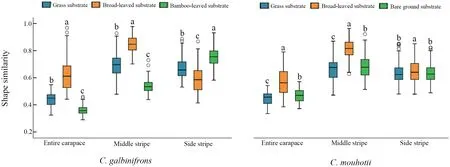
Figure 6 Shape similarity between each species and the leaves in the substrates.Different lowercase letters above the columns represent significant differences between each species’ carapace pattern on different substrates (t-tests or Mann-Whitney U-tests;P<0.05),with hollow cycle “o” indicating outliers in the data.

Table 3 Average shape similarity between both turtle species and leaves in the substrates.
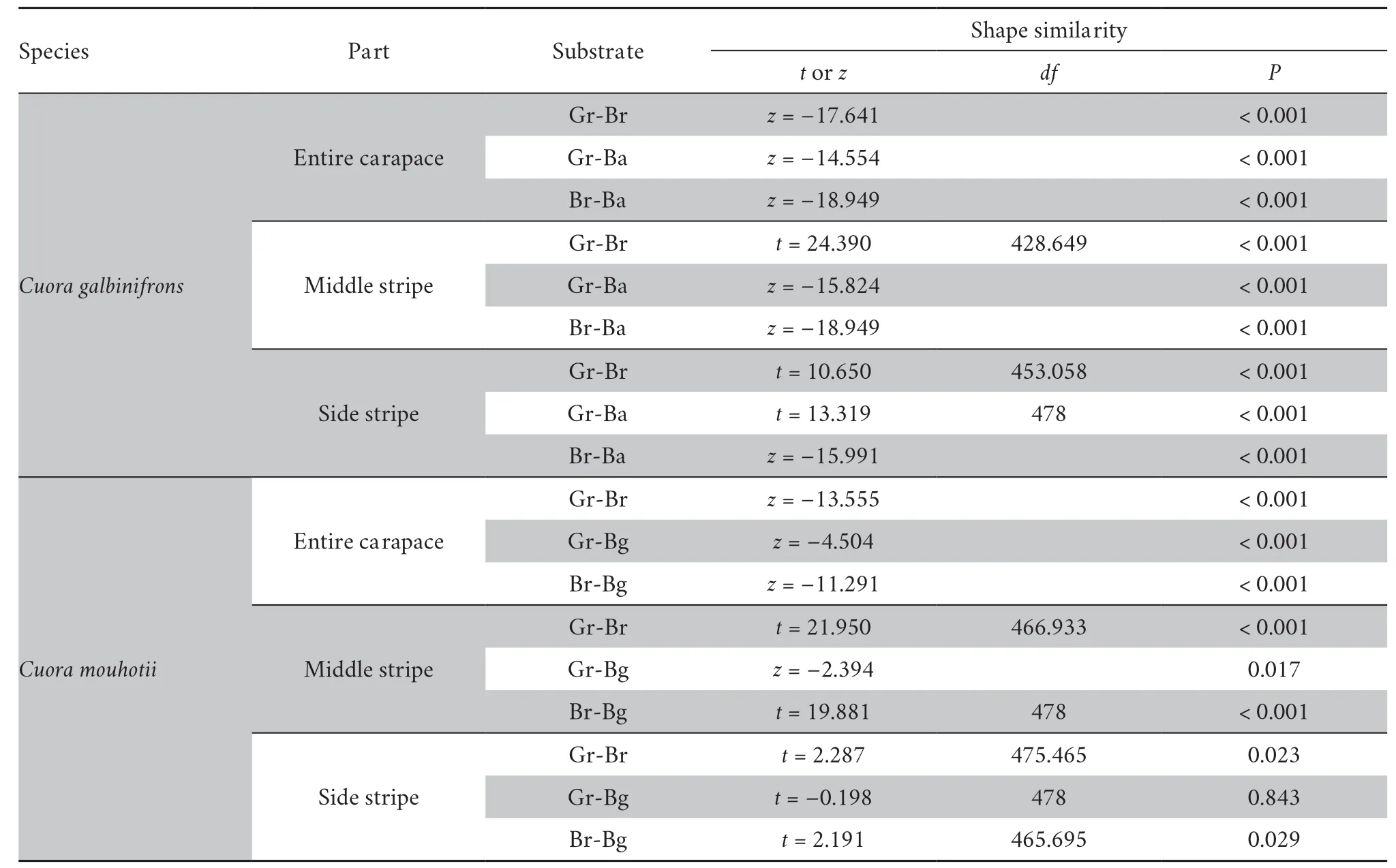
Table 4 Shape similarity between stripes of both turtle species and leaves in different substrates.
3.3.Color contrast between the contrast stripe of both turtle species and leavesThe entire carapace of each turtle species was the body part with the lowest similarity in shape to the leaves of each substrate,meaning that the shape of the entire carapace differs greatly from that of the leaves.Moreover,the carapaces of both species were divided by color or structure,making it an unsuitable feature to analyze color similarity as a whole.It was thus unnecessary to analyze any color similarity between the turtles’ entire carapace and the leaves.
The side stripe ofC.galbinifronshad a lower CJND with leaves from the bamboo-leaves substrate than with leaves from the broad-leaves and grass substrates.Furthermore,there was no significant difference between the CJND of its side stripe with the grass substrate and that of the broad-leaves substrate.ForC.mouhotii,the CJND between its middle stripe and leaves from its preferred substrates was higher than that between its middle stripe and the grass substrate.
ForC.galbinifrons,there were no significant differences in LJND between its side stripes and the leaves from grass and broad-leaves substrates;however,the highest LJND value was observed between its side stripes and leaves from the bambooleaves substrate.ForC.mouhotii,the highest LJND occurred between its middle stripe and leaves from the broad-leaves substrate (Figure 7,Tables 5-6).

Table 6 Differences in chromatic just-noticeable difference (CJND) and luminance just-noticeable difference (LJND) between contrast stripes in each species and leaves in different substrates.
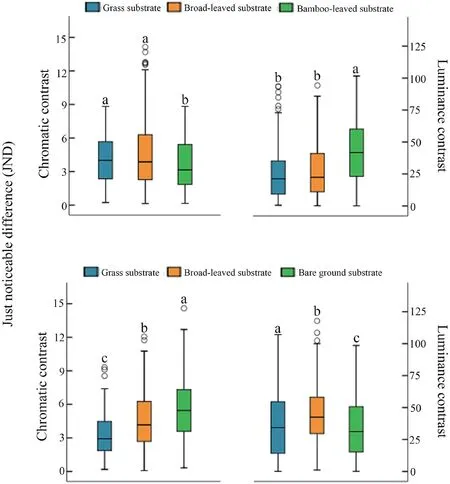
Figure 7 Vision modeling results of chromatic and luminance contrast between each species’ stripe and leaves in the substrates.The top panel shows the chromatic just-noticeable difference (CJND) and luminance just-noticeable difference (LJND) values between the side stripe of C.galbinifrons and leaves.The bottom panel shows the CJND and LJND values between the middle stripe of C.mouhotii and leaves.Different lowercase letters above the columns represent significant differences between each species’ carapace pattern on different substrates (t-tests or Mann-Whitney U-tests;P<0.05),with hollow cycle “o” indicating outliers in the data.

Table 5 Chromatic just-noticeable difference (CJND) and luminance just-noticeable difference (LJND) between both species’ contrast stripes and leaves in the substrate.
4.Discussion
We assessed the camouflage abilities of twoCuoraspecies in broad-leaves,bamboo-leaves,bare ground,and grass substrates;in all substrates,the CJND was within the human visual discrimination threshold.The color contrast analysis showed that the side stripe ofC.mouhotiiindividuals on their preferred substrates had the lowest CJND and LJND,whereas their middle stripe had the highest CJND and LJND.Conversely,the middle stripe ofC.galbinifronsindividuals on their preferred substrates had the lowest CJND and LJND,whereas their side stripe had the highest CJND and LJND.LJND is not only affected by color but also by the distance from the observer.The part closer to the observer is brighter,while the part further away is darker (Nakayama and Silverman,1986),resulting in a greater LJND in the stripes in different planes and the substrates.The high contrast between the middle and side stripes of each species also indicates that the partial stripes are highlighted in the substrate,which increases the disruptive camouflage for each species in their preferred substrate (Buet al.,2020).
Our previous long-term studies found that bothCuoraspecies prefer deciduous leaf substrates (Lian,2009;Wang,2007;Xiaoet al.,2017) and habitually semi-cover themselves in leaf litter.The middle stripe ofC.galbinifronsmatched the preferred substrates;however,the greater color difference observed between the middle stripes ofC.mouhotiiand the substrate may be because they are not in the same horizontal plane.When they semi-cover themselves,the middle stripes are in the same plane as the substrate,and the difference is expected to be much smaller.Both box turtle species adopt this strategy of covering themselves with leaves to better match their preferred substrate.Previous studies have demonstrated that some birds,crabs,and insects that cover themselves with decorations can reduce their detectability by predators (Holvecket al., 2017;Ruxton and Stevens,2015).This suggests that potential predators,such as humans,cannot discriminate visually between certain species and the substrate within which they are camouflaged.This strategy adds more noise to object discrimination at an early stage (Stevens and Cuthill,2006) and makes it more difficult for a predator to group the same features together visually(Espinosa and Cuthill,2014;Farmer and Taylor,1980).Our results indicate that both box turtle species may adopt a partial background matching camouflage strategy that reduces the contrast in their predator’s visual field,and they achieve this by semi-covering themselves in leaf litter.
The middle stripe on the carapace ofC.mouhotiiand the side stripe on the carapace ofC.galbinifronsdid not match their preferred substrates.A high-contrast pattern that does not match the background can impose a high survival cost (Cott,1940).In visual search experiments with specific targets,humans quickly learned that an unusual color is a clue that their target is present (Fraseret al.,2007).In many cases,the patterns on animals appear to be stand out from their background,which may make them vulnerable to predation (Cott,1940;Stevens and Merilaita,2011).However,in some cases a predator may detect prominent features of a prey individual but does not recognize them as part of an object that is worth examining(Cott,1940),an effect that has been demonstrated in humans through eye-tracking experiments (Websteret al.,2013).The middle stripe ofC.mouhotiiand the side stripe ofC.galbinifronsmay be interpreted by predators as leaves rather than as recognizable parts of turtles.Studies have shown that internal contrast markers can in fact provide protection,as predators treat them as separate objects by dividing the entire object into visually disconnected parts (Cuthillet al.,2005;Osorio and Srinivasan,1991;Schaefer and Stobbe,2006;Stevenset al.,2009).
The middle stripe of bothCuoraspecies shared the highest shape and color similarity levels with leaves from the broadleaves substrate,whereas the side stripe ofC.galbinifronshad the highest shape similarity with the bamboo-leaves substrate.When a predator has a short time frame within which to make a decision,the similarity between the species’ patterns and the background can provide protection (Hallet al.,2017).Several studies have demonstrated that patterned objects on a patterned background result in the slowest identification by predators.When objects are very similar in appearance,a predator’s tracking performance is impeded (Feria,2012;Hallet al.,2017;Howe and Holcombe,2012).The most promising evidence comes from a study on the four-eyed turtle (Sacalia quadriocellata),which showed that higher shape similarity resulted in a higher recognition error rate,indicating more effective camouflage (Xiaoet al.,2021).Interestingly,the middle stripe ofC.mouhotiihad greater chromatic contrast with their preferred substrates than with the grass substrate,meaning that the middle stripe in the preferred substrate can be easily detected by a predator.Despite contrasting in color with their preferred substrates,the middle stripe ofC.mouhotiiand the side stripe ofC.galbinifronsdid have a similar shape to that of the leaves.Previous studies have found that masquerading animals are usually similar in size,color,and shape to their model objects or species (Karpestamet al.,2014;Panettaet al.,2017;Skelhornet al.,2010b;Suzuki and Sakurai,2015).Furthermore,they frequently select the appropriate microhabitats to increase their similarity to the model (Nafuset al.,2015;Skelhorn and Ruxton,2013;Xiaoet al.,2021).For example,the caterpillars of the early thorn moth (Selenia dentaria) masquerade better when the density of a similar model increases (Skelhornet al.,2011).The common potoo bird selects perches on tree stumps that will effectively enhance their masquerading effect (Cestariet al.,2018).We believe that bothCuoraspecies adopt a partial masquerading strategy,rather than using their entire carapace as a means of camouflage.This allows them to increase their masquerading efficiency in varied substrates.
Our results showed that area accounted for the largest amount of similarity;however,perimeter,AR,S,C,and R(except for the roundness of the side stripe forC.galbinifrons)had high similarity among the four substrate types.Shape and size also have an important influence on the efficiency of camouflage through masquerading.Chiao and Hanlon(2001) found that cuttlefish (Sepia pharaonis) adjust their body markings based on the area of the objects against which they need to camouflage.Skelhorn and Ruxton (2013) found that the size of the moth larvae determines the efficiency of masquerading;however,Suzuki and Sakurai (2015) confirmed that,despite having the same size and area,caterpillars can affect their masquerading efficiency by changing their shape.
In the present study,area,perimeter,and the other four shape descriptors all had high similarity across habitats.This suggests that the similarity in shape between the turtle species’contrast stripes and the leaves of the habitat types is also a crucial aspect of their masquerading.Furthermore,human trichromatic vision is more sensitive to visual signals than the dichromatic vision of some other mammals (Caveset al.,2018;Trosciankoet al.,2017).Therefore,both turtle species would be camouflaged against the vision of these non-human mammals due to their shape similarity.
In conclusion,this is the first study to demonstrate that partial masquerading and background matching have a significant impact on turtles’ camouflage efficiency and habitat choice.C.galbinifronsandC.mouhotiiboth exhibited two types of camouflage strategies in their preferred substrates;partial masquerading was apparent when the entire carapace was exposed,and background matching was evident when the turtles were semi-covered in leaf litter.This study introduces a novel approach to camouflage studies that focuses on the influence of shape and color of parts of the body to reduce detectability or recognition.This study evaluated the camouflage effect for human vision,but did not analyze its effect on the turtles’ actual predators in the wild.Future research should explore the effects of turtles’ camouflage strategies on real predators in the wild.
AcknowledgmentsWe are grateful to Ling WANG,Tingting HUANG,and Zihao YE for assistance with image analysis.We also thank the Diaoluoshan National Nature Reserve for access to the field site and for providing assistance where necessary.Funding was provided by the National Natural Science Foundation of China (31772486) and the Hainan Provincial Natural Science Foundation of China(319MS047 and 320CXTD437).
杂志排行
Asian Herpetological Research的其它文章
- Elevational Variation in Reproductive Strategy of a Widespread Lizard:High-Elevation Females Lay Fewer but Larger Eggs
- Field Surveys Suggest Biennial Reproduction Cycle and Competition-triggered Dispersal of the Endangered Chinese Crocodile Lizard
- Morphology and Histochemistry of Infralabial Glands of Two Species in the Slug-Eating Family Pareidae (Reptilia: Serpentes)
- Effect of Morphology and Age on the Closure Ability of Asian Box Turtles(Cuora)
- A New Brown Frog of the Genus Rana (Anura,Ranidae) from North China,with a Taxonomic Revision of the R.chensinensis Species Group
